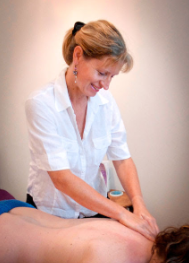Therapeutic Massage

Adelia Tisdall
I came to massage originally from a movement background, having studied Mime and Movement in London for 2 years. During this time I became very fascinated by the connection between mind and body and started having massage treatments myself in order to achieve what was known in Mime circles as the Body Neutral (basically a relaxed and natural body state). I found it so personally helpful that I carried on and did the training.
I qualified in ‘Holistic Massage’ (ITEC) in London in 1990. I then took additional courses in Advanced Massage and Sports Massage with the London School of Massage. In 2006 I did the first level of training in ‘Reconnective Healing’ whics a powerful form of spiritual healing.
Every massage is different because people are so different
Each body is its own kind of puzzle, and the key is to find the particular input that this body needs in order to release its tension and achieve a profound level of relaxation.
I have also completed a Foundation in ‘Core Process Psychotherapy’ and two years of training in Counselling (Gestalt based). Although I don’t work as a psychotherapist as such, these skills are useful in any therapeutic relationship. I have also had experience (and some training in) Zero Balancing, Touch for Health and Creative Kinesiology.
Over the years I have been involved in much personal development work and Focusing skills are probably the one thing which I have learned that I consider most useful and adaptable to bodywork.
I am fully insured and registered with the Federation of Holistic Therapists We are bound by a strict code of practice, details of which can be viewed by clicking on the link – Code of practice
Types of Massage
If you’re looking for a massage for the first time it can be quite confusing. There are a lot of different terms used and it’s hard to know what exactly they mean, or indeed if people even mean the same thing by them. My initial training was called “Holistic Massage” but in fact most foundation massage courses are based on Swedish massage techniques. This simply means a series of specific movements for physical manipulation of soft tissue and includes strokes such as petrissage, effleurage and percussion.
If a massage is described as an “Aromatherapy Massage” it is likely to be rather superficial as the essential oils are being considered the therapy rather than the massage. The terms ‘therapeutic’, ‘remedial’ and ‘deep tissue’ are used to denote a deeper and firmer massage which aims to address particular physical problems or facilitate a deeper level of release. These may sometimes be synonymous with “Sports Massage” although some Sports Massage therapists will also use other therapeutic treatments and suggest exercises to help strengthen muscles after injury, for example.
How I Work
So where do I fit in to all this I hear you asking? Well, every massage is different because people are so different. Many people like a deep massage and others prefer something more gentle or nurturing, and this can also change depending on how you are feeling at a particular time. I can also work in a remedial way on specific problem areas. If appropriate I also include passive stretches and sometimes ‘isometric’ stretches (where you do some of the work!).
However I have discovered over many years that sometimes less is more, and that making a connection with the body is much more important than applying brute force. I believe that working on the edge of pain can be very beneficial, but going over the edge is counter-productive and simply produces resistance in the client’s body (and mind). I prefer to gently encourage the body to give up its tension. However it is a dialogue with the body and everything is negotiable.

